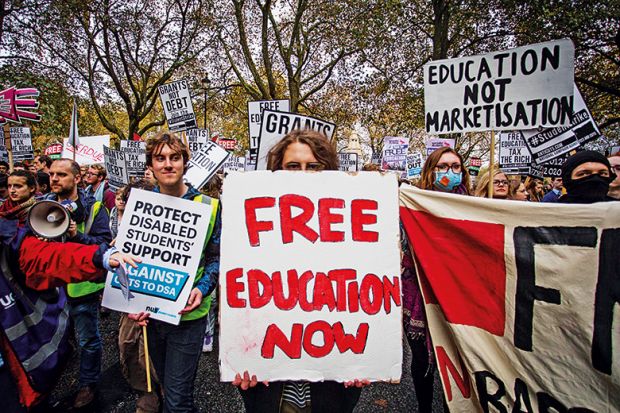It feels like the 1970s all over again. Free education, like free love, is popping up everywhere. The latest is Malaysia, where former long-serving leader Mahathir Mohamad – taking another tilt at the top job, as prime ministerial candidate of the Pakatan Harapan opposition alliance – pledged to abolish university fees if it won next month’s general election.
“Pakatan Harapan believes in free public education for all,” the alliance trumpeted in its alternative budget last October. “The provision of free public university education is an ideal that we must achieve within 10 years of taking over government.”
It turned out to be a short-lived ideal, according to the Free Malaysia Today news site, which this month reported that the alliance had decided to boost scholarships for underprivileged locals instead. The rationale was that students wouldn’t value education if it came gratis.
“I often see free food in schools thrown into the garbage bin,” Mahathir reportedly said. “Believe me, the majority of students will not study if we give them free (higher) education. They would think it is not important.”
To Morshidi Sirat, a former director general of Higher Education Malaysia, it was a wasted opportunity to create more meaningful changes to higher education policy. He says that free tuition is no longer a “hot issue” after the government’s tertiary education loans agency, Perbadanan Tabung Pendidikan Tinggi Nasional, implemented various measures to ease repayment problems.
Morshidi, now a professor with Universiti Sains Malaysia in Penang, says that it is surprising that Pakatan Harapan – whose leading lights include Muhyiddin Yassin, a former deputy prime minister and education minister – did not focus on more pressing issues such as graduate unemployment, particularly among people from the most disadvantaged households – known in Malaysia as the bottom 40 per cent or “B40”.
“While access to higher education has improved significantly, there are serious issues regarding success for the B40,” Morshidi says. “Free tuition fees may be relevant to this group, but it appears that this issue is muted this time around.”
He says that more scholarships to study locally would also have little impact, with few capacity constraints in Malaysia’s universities or the branch campuses of international institutions. The real need is for scholarships to study overseas, specifically for Malaysians of Chinese and Indian origin.
This populist obsession with free education, to the detriment of more useful considerations, is an issue that’s playing on my mind, as I prepare to cross the body of water separating Australians from our Kiwi cousins – affectionately known as “the Ditch” – for my first international trip as Times Higher Education’s Asia-Pacific editor.
Maybe it’s hypocritical to be downplaying current students’ concerns over their mounting debts, given that I’m old enough to have enjoyed free university in Australia. But to me, one of Australia’s most notable exports – the income-contingent loan – is a fantastic social instrument, funnelling cash into university systems while ensuring that access isn’t confined to the rich.
Experience in many countries shows that whether university is free or not, enrolments tend to be dominated by people from the upper crusts of society. Letting them study for free means that taxpayers who never benefit personally from university education end up subsidising those who do – the opposite of a progressive taxation system.
New Zealand’s abolition of tertiary education fees, phased in from this year after the surprise election victory of Labour’s Jacinda Ardern, is expected to benefit more vocational than higher education students. Advocates say that the policy has been misinterpreted, with its main goal to help struggling workers forced to retrain because of technological change – not comfortable 18-year-olds following the well-trodden route from school to university.
That’s fortunate, because there’s no evidence at this early stage that the policy has increased university enrolments one iota. Meanwhile, its staggering cost – NZ$2.5 billion (£1.3 billion) over five years – means that the country’s universities can’t expect much extra cash any time soon.
This will exacerbate their fiscally conservative inclinations to defer capital works and hire staff on short-term contracts, rather than risk tying up funds more permanently.
Meanwhile, in Britain, Jeremy Corbyn’s promise of free university has prompted Theresa May’s government to apply downward pressure on fees – great news for students but not the besieged universities.
Maybe things are different in places such as Norway, where taxes are high, oil reserves bolster sovereign wealth and free higher education is an act of faith. But elsewhere, student contributions play a vital role in keeping universities’ systems sustainable.
Here in Australia, most of the conversation – from the federal government, at any rate – has been about raising fees and making students repay loans more quickly. But free higher education remains on the policy platform of the Greens, the National Union of Students and the National Tertiary Education Union.
It was even one of the pledges of Clive Palmer, the mercurial mining magnate turned populist politician whose party won four seats in Australia’s 2013 election, and quickly lost them all.
Palmer is now being sued over allegations that he siphoned funds from his company Queensland Nickel, whose collapse in early 2016 left more than 800 people out of work and A$300 million (£163 million) in unpaid debts. Here’s hoping that higher education escapes a similar fate.
Register to continue
Why register?
- Registration is free and only takes a moment
- Once registered, you can read 3 articles a month
- Sign up for our newsletter
Subscribe
Or subscribe for unlimited access to:
- Unlimited access to news, views, insights & reviews
- Digital editions
- Digital access to THE’s university and college rankings analysis
Already registered or a current subscriber? Login








